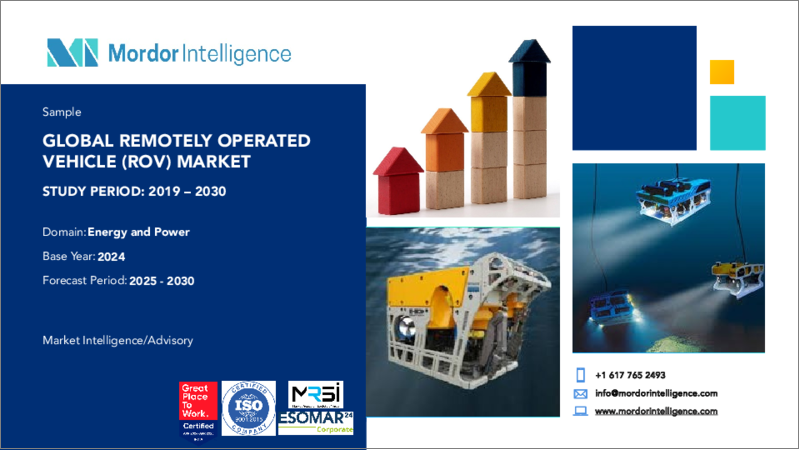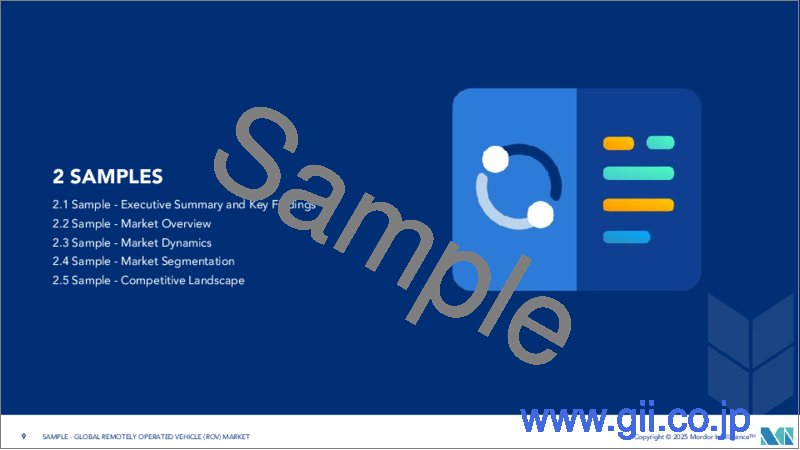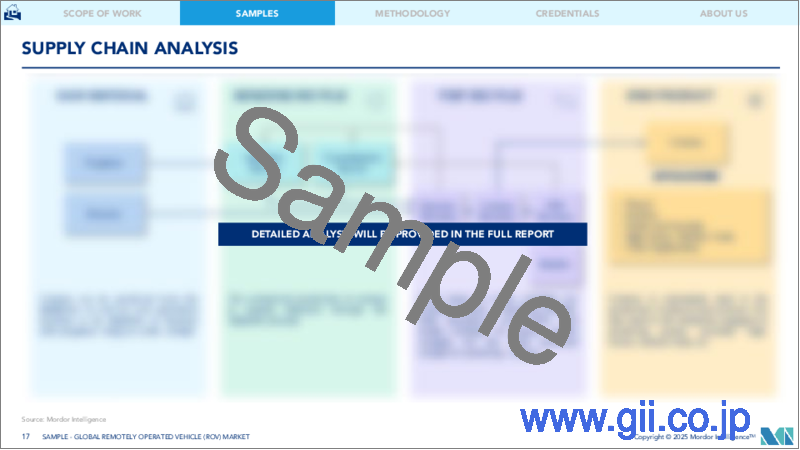|
|
市場調査レポート
商品コード
1640451
ROV:市場シェア分析、産業動向・統計、成長予測(2025~2030年)ROV - Market Share Analysis, Industry Trends & Statistics, Growth Forecasts (2025 - 2030) |
||||||
カスタマイズ可能
適宜更新あり
|
|||||||
| ROV:市場シェア分析、産業動向・統計、成長予測(2025~2030年) |
|
出版日: 2025年01月05日
発行: Mordor Intelligence
ページ情報: 英文 125 Pages
納期: 2~3営業日
|
全表示
- 概要
- 目次
概要
ROV市場規模は2025年に25億7,000万米ドルと推定され、予測期間中(2025~2030年)のCAGRは7.65%で、2030年には37億2,000万米ドルに達すると予測されます。

主要ハイライト
- 南北アメリカ、アジア太平洋、中東・アフリカにおける海洋石油・ガス探査活動の増加と、海洋再生可能技術の成長が、予測期間中のROV市場を牽引すると予想されます。
- 一方、複数の地域で海洋探査・生産活動が禁止されていることが、市場を抑制すると予想されます。
- しかし、現在進行中の深海・超深海での石油・ガス発見やシェールガス探査は、予測期間中にROV展開の大きな機会を生み出すと期待されています。
- 北米が世界の市場を独占し、需要の大半は米国とメキシコからもたらされました。北米は、先進的で機動性の高いROV開発で世界をリードしています。
ROV市場動向
石油・ガス用途セグメントが市場を独占する見込み
- 世界の主要経済国が依然として石油ベースの製品に大きく依存しているため、石油・ガスへの依存度が高まっています。石油・ガス産業は、国際政治・経済において絶大な影響力を持っています。
- Statistical Review of World Energy Dataによると、2022年の世界の石油生産量は9,987万7,000バレル/日で、前年比11.1%増でした。世界人口の増加は、一次エネルギー消費の増加を反映し、2011年の520.90エクサジュールから2022年には604.04エクサジュールとなりました。
- 石油輸出国機構(OPEC)によると、2023年の世界の原油需要(バイオ燃料を含む)は日量1億221万バレルに達します。この情報源は、経済活動とそれに関連する石油需要が年末までに回復し、日量1億400万バレル以上増加すると予測しています。
- 炭化水素産業は、石油・ガスの発見と生産を成功させるため、海底の条件に適した技術を開発してきました。石油・ガス掘削リグは、最大水深2マイルで操業することができます。深海の油井やパイプラインシステムの多くは、設置、検査、修理、保守を無人水中車両に頼っています。
- 過去数年間で、遠隔操作車両(ROV)は、ニッチな用途の新興技術から石油・ガスセグメントでの広範な用途へと進化しました。
- オフショア産業の設備投資も世界的に大幅に増加しており、特定の活動を行うための様々な先進技術、ツール、機器に対する需要が高まっています。これらのツールには、オフショア部門での保守点検作業を容易にするROVが含まれます。いくつかの石油・ガス会社は、海底調査をサポートするためにROVに投資しています。
- 例えば、2023年8月、Energeanは、遠隔操作車両(ROV)とサービスの世界のサプライヤーであるアバディーンに本拠を置くROVOPに5年間のROVサポート契約を発注しました。同社は、プラットフォーム供給船を改造したエナージアンの現場支援船エナージアン・スターにROVを配備します。
- ROVの技術的進歩は、その操作をより簡単かつ効率的にし、石油・ガス産業における需要を押し上げています。
- 全体として、ROVの需要は、急速に成長しているオフショア石油・ガスエネルギー事業のため、予測期間中に増加すると予想されています。遠隔操作オフショア車両に関連する技術にはいくつかの改良が加えられています。
北米が市場を独占する見込み
- この地域は、世界的に最も発達したオフショア石油・ガス産業の1つであり、主要重点地域はメキシコ湾とアラスカ沖地域の膨大な埋蔵量です。掘削深度が年々深まるにつれ、技術的に回収可能な埋蔵量も大幅に増加し、より多くの投資を引き寄せています。
- 米国が石油・ガス生産能力の拡大に多額の投資を行ったため、メキシコ湾はROV需要の世界のホットスポットとなりました。米国エネルギー情報局によると、2022年、メキシコ湾連邦沖の石油・天然ガス生産量は、米国の原油総生産量の約15%を占めました。この地域は、オフショア・リグの配備密度が世界で最も高い地域の1つです。同地域は、生産・掘削プラットフォーム、海洋船舶、パイプライン・ネットワークなど、その他の石油・ガスインフラで構成されています。
- 米国は国防予算に世界最多を投じており、ROV船の研究開発のパイオニアです。2023年5月、米国海軍は、深海をパトロールし、小型潜水艇や無人偵察機を配備するハイテク船に最大51億米ドルを投資する計画を発表しました。このような投資は北米のROV市場を牽引すると予想されます。
- ROV技術の低価格化が進むなか、米国の石油・ガス生産者は、海底資産や地表のデータ取得や定期保守作業を行うためにROVサービスに投資しています。潜水作業員に比べて初期費用は高いもの、ROVは同じ量の作業を完了するのに必要な時間が短いため、プロジェクト全体のOPEXを削減できます。
- 2024年5月、米国のオフショアサービス会社Edison Chouestは、アバディーンを拠点とする遠隔操作車両プロバイダーROVOPを買収しました。この買収により、同社の保有するROVは100台以上、自律型水中車両は6台となる見込みです。産業におけるこのような活動は、コスト削減とROVの信頼性向上につながると期待されています。
- このように、北米のROV産業は非常に発展しています。海洋建設や石油・ガスサービスの需要増加に伴い、同産業は予測期間中も急成長を続けると予想され、同地域のROV需要を牽引しています。
ROV産業概要
ROV市場は細分化されています。市場の主要企業(順不同)には、DeepOcean AS、DOF Subsea AS、Oceaneering International Inc.、Helix Energy Solutions Group Inc.、TechnipFMC PLCなどがあります。
その他の特典
- エクセル形式の市場予測(ME)シート
- 3ヶ月間のアナリストサポート
目次
第1章 イントロダクション
- 調査範囲
- 市場の定義
- 調査の前提
第2章 エグゼクティブサマリー
第3章 調査手法
第4章 市場概要
- イントロダクション
- 2029年までの市場規模と需要予測(単位:10億米ドル)
- 最近の動向と開発
- 政府の規制と施策
- 市場力学
- 促進要因
- 南北アメリカ、アジア太平洋、中東・アフリカにおける石油・ガス海洋探査活動の増加
- オフショア再生可能技術の成長
- 抑制要因
- 複数地域におけるオフショア探査・生産活動の禁止
- 促進要因
- サプライチェーン分析
- ポーターのファイブフォース分析
- 供給企業の交渉力
- 消費者の交渉力
- 新規参入業者の脅威
- 代替品の脅威
- 競争企業間の敵対関係の強さ
第5章 市場セグメンテーション
- タイプ
- 作業クラスROV
- 観測クラスROV
- 用途
- 石油・ガス
- 防衛
- その他
- 深海海洋探査
- 活動
- 測量
- 点検、修理、メンテナンス
- 埋設とトレンチ掘削
- その他の活動
- 地域
- 北米
- 米国
- カナダ
- その他の北米
- 欧州
- ドイツ
- デンマーク
- ノルウェー
- 英国
- イタリア
- ノルディック
- ロシア
- フランス
- トルコ
- その他の欧州
- アジア太平洋
- 中国
- インド
- 日本
- オーストラリア
- タイ
- マレーシア
- インドネシア
- ベトナム
- その他のアジア太平洋
- 南米
- ブラジル
- アルゼンチン
- コロンビア
- その他の南米
- 中東・アフリカ
- サウジアラビア
- アラブ首長国連邦
- ナイジェリア
- 南アフリカ
- カタール
- エジプト
- その他の中東・アフリカ
- 北米
第6章 競合情勢
- M&A、合弁事業、提携、協定
- 主要企業の戦略
- 企業プロファイル
- DeepOcean AS
- DOF Subsea AS
- Helix Energy Solutions Group Inc.
- TechnipFMC PLC
- Bourbon Corporation SA
- Fugro NV
- Oceaneering International Inc.
- Saab Seaeye Limited
- Forum Energy Technologies Inc.
- Saipem SpA
- Delta SubSea LLC
- ROVOP
- List of Other Prominent Players
- 市場ランキング/シェア(%)分析
第7章 市場機会と今後の動向
- 進行中の深海・超深海石油・ガス発見
目次
Product Code: 53122
The ROV Market size is estimated at USD 2.57 billion in 2025, and is expected to reach USD 3.72 billion by 2030, at a CAGR of 7.65% during the forecast period (2025-2030).

Key Highlights
- Increasing offshore oil and gas exploration activities in the Americas, Asia-Pacific, and Middle East and Africa and growing offshore renewable technologies are expected to drive the ROV market during the forecast period.
- On the other hand, the ban on offshore exploration and production activities in multiple regions is expected to restrain the market.
- However, the ongoing deepwater and ultra-deepwater oil and gas discoveries and shale gas explorations are expected to create huge opportunities for ROV deployment over the forecast period.
- North America dominated the market worldwide, with most of the demand coming from the United States and Mexico. North America is still leading the world with its advanced, highly maneuverable ROV development.
ROV Market Trends
The Oil & Gas Application Segment is Expected to Dominate the Market
- The dependence on oil and gas increases as major economies globally still rely heavily on petroleum-based products. The oil and gas industry displays immense influence in international politics and economics.
- According to the Statistical Review of World Energy Data, global oil production in 2022 was 99,877 thousand barrels per day, an increase of 11.1% over the previous year. The increase in global population reflected an increase in primary energy consumption, which stood at 604.04 exajoules in 2022, up from 520.90 exajoules in 2011.
- According to the Organization of the Petroleum Exporting Countries (OPEC), in 2023, the global demand for crude oil (including biofuels) amounted to 102.21 million barrels per day. The source expects economic activity and related oil demand to pick up by the end of the year, with the projections suggesting an increase of more than 104 million barrels per day.
- Many potential global reserves of hydrocarbons lie beneath the sea, and the hydrocarbon industry has developed techniques suited to the conditions found in offshore sites to find and produce oil and gas successfully. Oil and gas drilling rigs may operate in up to two miles of water depth. Many deepwater wells and pipeline systems rely on unmanned underwater vehicles to help perform installations, inspections, repairs, and maintenance.
- Over the past few years, remotely operated vehicles (ROV) have evolved from emerging technology with niche uses to extensive applications in the oil and gas sector.
- Capital expenditure in the offshore industry is also increasing significantly worldwide, thus boosting the demand for various advanced technologies, tools, and equipment to perform certain activities. These tools include the ROVs, as they ease the maintenance and inspection work in the offshore sector. Several oil and gas companies are investing in ROVs to support subsea surveys.
- For instance, in August 2023, Energean awarded a five-year ROV support contract to Aberdeen-based ROVOP, a global supplier of remotely operated vehicles (ROVs) and services. The company will deploy its ROVs onboard Energean's field support vessel, Energean Star, a converted platform supply vessel.
- Technological advancements in ROVs make their operations easier and more efficient, thus boosting their demand in the oil and gas industry.
- Overall, the demand for ROVs is expected to increase during the forecast period due to the rapidly growing offshore oil, gas, and energy operations. There have been several improvements in the technologies associated with remote-operated offshore vehicles.
North America is Expected to Dominate the Market
- The region has one of the most well-developed offshore oil and gas industries globally, with the primary areas of focus being the vast reserves in the Gulf of Mexico and the offshore Alaska region. With the drilling depths increasing over the years, the volume of technically recoverable reserves has also increased significantly, thus attracting more investments.
- As the United States invested heavily in expanding its oil and gas production capacity, the Gulf of Mexico has become a global hotspot for ROV demand. According to the US Energy Information Administration, in 2022, oil and natural gas production in the Federal Offshore Gulf of Mexico accounted for about 15% of total US crude oil production. The region has one of the highest global densities of offshore rig deployment. It comprises other oil and gas infrastructure, such as production and drilling platforms, marine vessels, and pipeline networks.
- The United States spends the most globally on its defense budget and has pioneered R&D on ROV vessels. In May 2023, the US Navy announced its plans to invest up to USD 5.1 billion in high-tech vessels that would patrol the deepest reaches of the ocean and deploy mini-subs and drones. Such types of investments are expected to drive the ROV market in North America.
- As ROV technology has become increasingly affordable, oil and gas producers in the United States are investing in ROV services to obtain data and perform routine maintenance work on subsea assets and surfaces. Despite the higher upfront cost compared to diving crews, ROVs need less time to complete the same amount of work, which reduces overall project OPEX.
- In May 2024, Edison Chouest, a US offshore services company, acquired Aberdeen-based remotely operated vehicle provider ROVOP. The deal will likely boost the company's fleet to over 100 ROVs and six autonomous underwater vehicles. Such activities in the industry are expected to reduce costs and increase ROV reliability.
- Thus, the ROV industry in North America is highly developed. As demand increases for marine construction and oil and gas services, the industry is expected to keep growing fast during the forecast period, thereby driving the demand for ROVs in the region.
ROV Industry Overview
The ROV market is semi-fragmented. Some of the major players in the market (in no particular order) include DeepOcean AS, DOF Subsea AS, Oceaneering International Inc., Helix Energy Solutions Group Inc., and TechnipFMC PLC.
Additional Benefits:
- The market estimate (ME) sheet in Excel format
- 3 months of analyst support
TABLE OF CONTENTS
1 INTRODUCTION
- 1.1 Scope of the Study
- 1.2 Market Definition
- 1.3 Study Assumptions
2 EXECUTIVE SUMMARY
3 RESEARCH METHODOLOGY
4 MARKET OVERVIEW
- 4.1 Introduction
- 4.2 Market Size and Demand Forecast in USD billion, till 2029
- 4.3 Recent Trends and Developments
- 4.4 Government Policies and Regulations
- 4.5 Market Dynamics
- 4.5.1 Drivers
- 4.5.1.1 Increasing Offshore Oil & Gas Exploration Activities in the Americas, Asia-Pacific, and Middle East and Africa
- 4.5.1.2 Growing Offshore Renewable Technologies
- 4.5.2 Restraints
- 4.5.2.1 Ban on Offshore Exploration and Production Activities in Multiple Regions
- 4.5.1 Drivers
- 4.6 Supply Chain Analysis
- 4.7 Porter's Five Forces Analysis
- 4.7.1 Bargaining Power of Suppliers
- 4.7.2 Bargaining Power of Consumers
- 4.7.3 Threat of New Entrants
- 4.7.4 Threat of Substitute Products and Services
- 4.7.5 Intensity of Competitive Rivalry
5 MARKET SEGMENTATION
- 5.1 Type
- 5.1.1 Work Class ROV
- 5.1.2 Observatory Class ROV
- 5.2 Application
- 5.2.1 Oil and Gas
- 5.2.2 Defense
- 5.2.3 Other Applications
- 5.2.4 Deep Sea Marine Exploration
- 5.3 Activity
- 5.3.1 Survey
- 5.3.2 Inspection, Repair, and Maintenance
- 5.3.3 Burial and Trenching
- 5.3.4 Other Activities
- 5.4 Geography
- 5.4.1 North America
- 5.4.1.1 United States
- 5.4.1.2 Canada
- 5.4.1.3 Rest of North America
- 5.4.2 Europe
- 5.4.2.1 Germany
- 5.4.2.2 Denmark
- 5.4.2.3 Norway
- 5.4.2.4 United Kingdom
- 5.4.2.5 Italy
- 5.4.2.6 NORDIC
- 5.4.2.7 Russia
- 5.4.2.8 France
- 5.4.2.9 Turkey
- 5.4.2.10 Rest of Europe
- 5.4.3 Asia-Pacific
- 5.4.3.1 China
- 5.4.3.2 India
- 5.4.3.3 Japan
- 5.4.3.4 Australia
- 5.4.3.5 Thailand
- 5.4.3.6 Malaysia
- 5.4.3.7 Indonesia
- 5.4.3.8 Vietnam
- 5.4.3.9 Rest of Asia-Pacific
- 5.4.4 South America
- 5.4.4.1 Brazil
- 5.4.4.2 Argentina
- 5.4.4.3 Colombia
- 5.4.4.4 Rest of South America
- 5.4.5 Middle East and Africa
- 5.4.5.1 Saudi Arabia
- 5.4.5.2 United Arab Emirates
- 5.4.5.3 Nigeria
- 5.4.5.4 South Africa
- 5.4.5.5 Qatar
- 5.4.5.6 Egypt
- 5.4.5.7 Rest of Middle East and Africa
- 5.4.1 North America
6 COMPETITIVE LANDSCAPE
- 6.1 Mergers and Acquisitions, Joint Ventures, Collaborations, and Agreements
- 6.2 Strategies Adopted by Leading Players
- 6.3 Company Profiles
- 6.3.1 DeepOcean AS
- 6.3.2 DOF Subsea AS
- 6.3.3 Helix Energy Solutions Group Inc.
- 6.3.4 TechnipFMC PLC
- 6.3.5 Bourbon Corporation SA
- 6.3.6 Fugro NV
- 6.3.7 Oceaneering International Inc.
- 6.3.8 Saab Seaeye Limited
- 6.3.9 Forum Energy Technologies Inc.
- 6.3.10 Saipem SpA
- 6.3.11 Delta SubSea LLC
- 6.3.12 ROVOP
- 6.4 List of Other Prominent Players
- 6.5 Market Ranking/Share (%) Analysis
7 MARKET OPPORTUNITIES AND FUTURE TRENDS
- 7.1 Ongoing Deepwater and Ultra-deepwater Oil and Gas Discoveries





